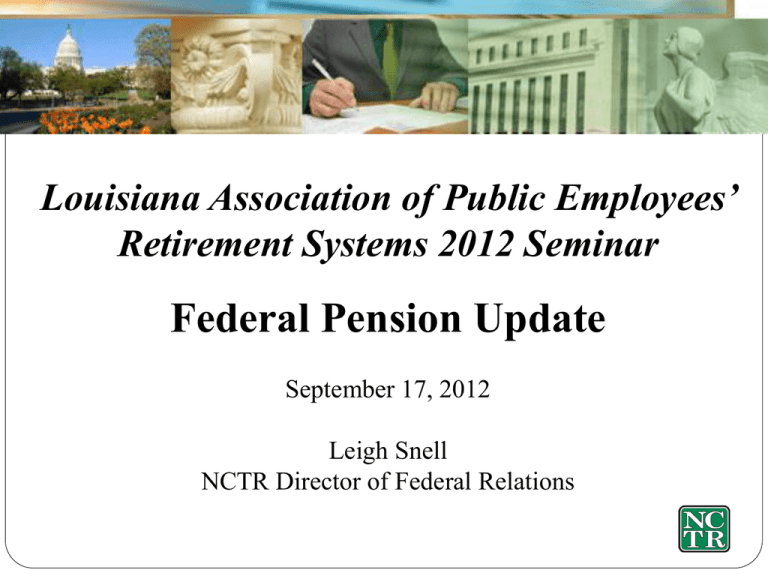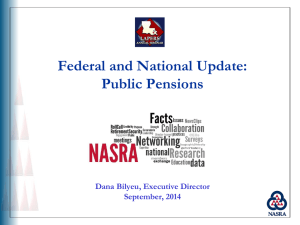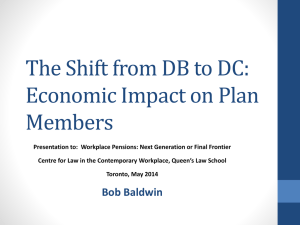The TRUTH About Public Plans` Financial Sustainability
advertisement

Louisiana Association of Public Employees’ Retirement Systems 2012 Seminar Federal Pension Update September 17, 2012 Leigh Snell NCTR Director of Federal Relations What You Hear About Public Plans’ Financial Sustainability: Public Plans are going broke! Median public pension annualized return 1/1/2011 -- 12/31/2011 was 0.8 percent! Unfunded liabilities are $3 to $4 trillion! Public Plans are bankrupting cites and states! San Bernardino and Stockton, CA; Central Falls, RI; the Federal government is considering allowing states to file. Public Plans are taking too many investment risks! “Rosy” investment return assumptions lead to Hedge funds! Alternative investments! Private equity! Lions! And tigers!! And bears!!! OH MY!!!! The TRUTH About Public Plans’ Financial Sustainability: Public Plans are NOT going broke! According to the U.S. Census Bureau, total assets among state and local employee retirement systems grew in FY10 after falling for the two previous fiscal years. The TRUTH About Public Plans’ Financial Sustainability: The TRUTH About Public Plans’ Financial Sustainability: Public Plans are NOT going broke! Funding level for all state plans combined was 77% in 2011, up from 69% in 2010, according to Wilshire. As of the first quarter of 2012, state and local government retirement systems held assets of approximately $3 trillion. Over $200 billion distributed annually from pension trusts, not from general revenue. The TRUTH About Public Plans’ Financial Sustainability: Public Plans are NOT bankrupting cites and states! Based on most recent U.S. Census Bureau info, approx. 3% of all state, local government spending is used to fund their pension benefits. (As percentage of total spending, pension costs for cities are higher by about 50 percent.) Since 1980, pension costs have been reliably stable, declining from around 4% to nearly 3% in 2009. Over $1 trillion in total economic output attributable to DB pension expenditures in 2009, supporting 6.5 million American jobs and $134 billion in state, local taxes. The TRUTH About Public Plans’ Financial Sustainability: Plans are NOT taking too many investment risks! Average public pension fund asset allocation, based on latest information from the Public Fund Survey: Public equities: 52% Fixed income: 27% Real estate: 6% Alternative investments: 10% Absolute/Real return: 3% Cash: 2% The TRUTH About Public Plans’ Financial Sustainability: Plans are NOT taking too many investment risks! Discount rate controversy – use a “risk-free” rate or the expected rate of return based on the portfolio. Makes a huge difference in measuring the liabilities. The discount rate is a snapshot in time – one frame out of thousands that make up a movie. It may be interesting in and of itself, but it doesn’t tell the whole story. The TRUTH About Public Plans’ Financial Sustainability: Consider the case of a newly-hired public school teacher who is 25 years old. If this teacher chooses to make a career out of teaching school, he or she may work for 35 years, to age 60, and live another 25 years, to age 85. This teacher’s pension plan will receive contributions for the first 35 years and then pay out benefits for another 25 years. During the entire 60-year period, the plan is investing assets on behalf of this participant. To emphasize the long-term nature of the investment return assumption, for a typical career employee, more than one-half of the investment income earned on assets accumulated to pay benefits is received after the employee retires. Source: NASRA Update on Legislative and Regulatory Issues Affecting Public Pensions 1. Where have we been? 2. Where are we now? 3. Where are we going? Where Have We Been: the 1990’s 1996: Small Business Job Protection Act -- Section 415 “fix;” 457 plan assets put in trust. 1997: Taxpayer Relief Act -- purchase of permissive service credits enhanced; permanent moratorium on application of nondiscrimination testing to public plans. 2001: EGTRRA -- use of 403(b) and 457 plan assets to purchase service credits through direct trustee-to-trustee exchanges; increased 415(b) dollar limits; catch-up contributions to 401(k),403(b), and governmental 457 plans for participants who are age 50+. That Was Then…. This is Now!! Welcome to the 21st Century Pension Protection Act of 2006 (PPA) MVL and the discount rate controversy GASB revisits Statements 25, 27 Hedge Funds/Commodities Divestment Normal Retirement Age Regulations IRS Governmental Plans Roundtable; Survey Questionnaire SEC: Pay-to-Play; New Enforcement Unit on Public Pensions; San Diego; New Jersey settlements Where are we now? Where are we now -- the Congress 2/9/2011 – “State and Municipal Debt: The Coming Crisis?” 2/14/2011 – “The Role of Public Employee Pensions in Contributing to State Insolvency and the Possibility of a State Bankruptcy Chapter” 3/15/2011 – “State and Municipal Debt: The Coming Crisis? Part II” 4/14/2011 - "State and Municipal Debt: Tough Choices Ahead” 5/5/2011 – “Transparency and Funding of State and Local Pension Plans” Public Employee Pension Transparency Act PEPTA HR 567 (Nunes, Ryan, Issa); S 347 (Burr) Sponsors of state and local government plans to report funding information annually to the Secretary of the Treasury using market value of liabilities (MVL); Treasury could impose new, yet to be defined “comparability” standards. Voluntary, but failure to report information would lose sponsor the ability to issue Federal tax-exempt debt. Prohibits Federal bail-out of public pension debt. PEPTA Congressman Nunes: “trying to smoke the rats out of their holes;” public pension underfunding could be a great as $15 trillion. Higher liabilities will grease the way towards explicitly permitting states to declare bankruptcy; allowing States in bankruptcy could give them the ability to renegotiate obligations, enabling them to slash public employees’ benefits; Reuters: “From the Republican perspective, the fiscal crisis on the state level provides a golden opportunity to defund key Democratic interest group. For the GOP, it’s an economic and political win.” Moody’s Proposal: “Backdoor” PEPTA? Actuarial accrued liability (AAL) for 2010, 2011 would be discounted using a high-grade long-term corporate bond index rate of 5.5%. Smoothing would be eliminated in favor of reported fair market value of assets as of the actuarial reporting date. The proposed UAAL amortization payment adjustment will be a simple 17-year level dollar amortization payment. For multiple-employer cost-sharing plans, liabilities would be allocated proportionately according to each employer’s share of the total contribution. Moody’s Proposal: “Backdoor” PEPTA? Moody’s estimates that fiscal 2010 reported unfunded actuarial accrued liability (UAAL) for the 50 states and the local governments that it rates (covering 3,500 pension plans) would nearly triple: from $766 billion to $2.2 trillion. For states, Moody’s adjustments to annual contribution amounts would increase annual contributions from $36.6 billion to $128.8 billion (or from 2.6 percent of revenue to 9.1 percent of revenue). Who needs PEPTA? Comments due by September 30, 2012. Congressional Studies Congressional Budget Office (CBO) May 2011 report, “The Underfunding of State and Local Pension Plans” MVL “more fully accounts for the costs that pension obligations pose for taxpayers;” “Most of the additional funding needed to cover pension liabilities is likely to take the form of higher government contributions and therefore will require higher taxes or reduced government services for residents;” If states’ financial condition worsens, “the federal government might be asked to assist in the funding of such plans” which could raise the federal deficit and debt. Congressional Studies Congressional Joint Economic Committee Republican Commentary, December 2011: “States Of Bankruptcy: The Coming State Pensions Crisis,” May 2012: “Eurozone USA?” Many plans projected to run out of money in five years; Massive unfunded pension liabilities, poor economic policies willlead to “a Greek-style fiscal death spiral;" “The state pension crisis is virtually unavoidable;” Pre-emptive actions by Congress can “help prevent a taxpayer bailout of state pension systems.” Congressional Studies Senate Finance Committee Report by Ranking GOP Senator Orrin Hatch (R-UT), January , 2012, “State and Local Government Defined Benefit Pension Plans: The Pension Debt Crisis that Threatens America” When S&P downgraded United States debt in August, 2011, one of the key factors was underfunded state and local government pensions; Retirees may not receive their full pensions, thus threatening to increase the costs of federal poverty programs; DB plans: “inappropriate for state and local governments,” Mandatory Social Security In Louisiana, about 72% of state and local government employees are not covered by Social Security. Then: too disruptive and costly for State and local governments; too little benefit to overall Social Security reform; unlikely to be considered separate and apart from Social Security solvency. Now: necessary pension reform; help states and localities “get their fiscal houses in order,” avoid Federal bailout Mandatory Social Security Deficit Commission : excluding some public employees from Social Security and instead maintaining separate retirement systems “has become riskier for both government sponsors and for program participants and a potential future bailout risk for the federal government” The Domenici-Rivlin Task Force : requiring all newlyhired state , local employees after 2020 to be covered under Social Security will “provide better disability and survivor insurance protection for many workers who move between government employment and other jobs. ” Mandatory Social Security Mandatory SS without major Social Security reform? If Congress becomes convinced that it must “do something” to address a perceived public pension crisis, mandatory coverage could surface as part of an overall package designed to make State and local governments “reform” their pensions to become more sustainable If mandatory coverage is effectively removed from the context of overall Social Security reform, where it has always been able to be argued as providing too little relief at too great a cost, it will change the entire tenor of the discussion Where Are We Now – Treasury/IRS Definition of a Governmental Plan ANPRM Governmental plans are exempt from the reporting, participation, vesting, and fiduciary standards of ERISA. Other tax code provisions treat a governmental plan differently from other plans. However, since ERISA became law in 1974, there have never been regulations governing the definition of what it means to be a “governmental plan.” This is all about to change. This is a BIG DEAL! Where Are We Now – Treasury/IRS Definition of a Govt Plan ANPRM Main Factors. Control of Governing Body. Public Election of Governing Body. Fiscal Responsibility. Treatment of Employees as Public Employees. Delegated Sovereign Powers. Where Are We Now – Treasury/IRS Definition of a Govt Plan ANPRM Other Factors. Operational Control. Direct Funding. Specific Enabling Law. Treatment as Govt Entity for Federal Tax Purposes. Treatment Under State Law. Court Decision. No Private Interest. Serves a Governmental Purpose. Where Are We Now – Treasury/IRS Definition of a Govt Plan ANPRM Town Hall meetings in Oakland and Cleveland Telephone forum Written Comments by June 18th Public hearing in Washington on July 9th – NCTR and NASRA were there! Multi-year process Where Are We Now – Treasury/IRS Definition of a Govt Plan – NCTR/NASRA Comments Safe Harbors: Elected Board -- majority either controlled by State/political subdivision or elected through periodic, publicly held elections. Sovereign Powers – taxation, police, eminent domain, others as defined by the state constitution. Federal Tax – 218 agreement; authority to issue tax-exempt bonds; a 115 ruling (determination of status). Federal Law -- treated as agency/instrumentality pursuant to a federal law (other than IRC) or by other federal agency. Court Ruling -- state or federal court rulinbg as to status. Where Are We Now – Treasury/IRS Definition of a Govt Plan – NCTR/NASRA Comments Grandfathering (could apply to both current and future employees of the entity, but should be permissive based upon the plan provisions) if entity, as of the effective date of the final regulations: has favorable private letter ruling. is participating pursuant to specific terms of state or local law. is in a multiple employer plan and is participating pursuant to a procedure provided for in the plan document (i.e. where plan document allows nonprofit instrumentalities to participate in plan subject to approval by plan's governing body). Where Are We Now – Treasury/IRS Normal Retirement Age Regulations Released in final form in 2007 Extended application to governmental plans; set to apply in January of 2013 Problems with use of service in defining the time when employee was eligible for unreduced benefit Safe harbors in regs were unworkable for public plans Where Are We Now – Treasury/IRS Normal Retirement Age Regulations – Big Problems Public plans often define normal retirement “age” as more a normal retirement “date,” based on service. Participant can reach NRA by satisfying one of several age and service combinations; defining an NRA as a single “age” creates major problems, i.e. impairment if age is higher than the lowest age, or actuarial cost increases if age is lower than the highest age. Safe harbors: how to determine typical retirement age for the “industry in which the covered workforce is employed” in the diverse public sector setting. Where Are We Now – Treasury/IRS Normal Retirement Age Regulations – New Notice Notice of intent to amend regulations for public plans; January 2015 earliest that new regs could apply. Focus is on in-service distributions before age 62. Plans "will not fail to satisfy the requirement that the plan provide definitely determinable benefits to employees after retirement or attainment of normal retirement age merely because the pension plan does not have a definition of normal retirement age or does not have a definition of normal retirement age that satisfies the requirements of the 2007 NRA regulations." Where Are We Now – Treasury/IRS Normal Retirement Age Regulations – New Problems? What exactly is an in-service distribution? What about return-to-work programs? How would part-time work be affected? Does one rotten apple spoil the whole barrel? If the regs do apply (i.e., there are in service distributions before age 62), what about the safe harbor problems? Where Are We Now – Treasury/IRS Normal Retirement Age Regs – NCTR/NASRA comments Issuance of proposed rules and comment period prior to finalization of normal retirement age regs Clarify that restrictions on governmental plan normal retirement ages pertain to in-service distributions before age 62 ONLY and not to other provisions such as eligibility for unreduced benefits, etc. Treat the time at which participant in a governmental plan qualifies for unreduced benefit to be acceptable NRA for the purposes of the 2007 regulations. Where Are We Now – SEC More enforcement actions in the works similar to New Jersey. Regulation of pension disclosures in bond offerings? NABL “considerations.” “Special” treatment of public pension investors. Independent, more reliable funding mechanism for GASB; SEC oversight. Where Are We Now – SEC Muni Advisor Rule Proposed 12/20/2010: appointed trustee need to register as municipal advisors; only elected are exempt. NCTR/NASRA: as members of the governing body of a state or local retirement system, public pension trustees are part and parcel of the plan that they govern, and not advisers to it, and thus exempt. To hold otherwise would mean that any third party who provides advice to governing body of municipal entity would NOT be required to register as muni advisor, nor be subject to other municipal advisor provisions of the Dodd-Frank Act. Where Are We Now – SEC Muni Advisor Rule Extraordinary number of responses from muni advisors. Letter from bipartisan group of 35 members of the House of Representatives says SEC “goes far beyond the statute’s intent and scope by capturing, in the ‘municipal advisor’ definition, parties and activities that were not anticipated by Congress or authorized by the statute,” including “appointed volunteer public servants.” SEC Chair Mary Shapiro concedes to Congress that the agency “may have cast the net too widely.” Look for final rule in second half of 2012. Where Are We Now – GASB “New ARC” Project: Pension funding task force established at the request of “Big 7,” (NGA, NCSL, Council of State Governments, NACo, NLC, U.S. Conference of Mayors, and International City/County Management Association. In addition, NASACT, GFOA, NASRA and NCTR. Center for State and Local Government Excellence is the convening organization. Goals are (1) to have accepted, recommended funding standards, practices in place by the time new GASB rules are implemented; and (2) identify a method for voluntary compliance with recommended standards and practices. Where Are We Now – GASB General Policy Objectives for Pension Funding Funding plan based on actuarially determined contributions. A disciplined approach to funding so that promised benefits can be paid. Generational equity so that the cost of benefits are funded during an employee’s working years. Employer costs are a consistent percentage of payroll. Clear reporting showing how, when plans will be fully funded. Will address actuarial cost method, asset smoothing and amortization; intent is to provide guidance on both accepted and recommended practices. Where are we going? Lame Duck Debt ceiling increase and GOP demands for increased deficit reduction as a trade-off raise possibilities for mandatory Social Security, repeal of employer pick-ups. Deal on expiring Bush tax cuts could also involve some tax reforms involving tax expenditures to offset costs. Must-do legislation could offer vehicle for PEPTA – it already has! Where are we going? 2013 Tax reform REFORM or reform? Tax expenditures – “Everything’s on the table” What about DBs? Will only DC’s be impacted? Tax Expenditures Losses to the Treasury from granting certain deductions, exemptions, deferrals or credits; total budget impact of income tax expenditures in 2011 is almost $1.2 trillion. Largest FY 2009 tax expenditures: exclusion of health benefits ($94.4 billion); home mortgage deduction ($86.4 billion), and net exclusion of pension contributions. earnings ($73 billion). For DB plans alone, $275.7 billion for FY 2009-2013. Pension Tax Expenditure Recommendations Deficit Commission: consolidate retirement accounts; cap tax-deferred contributions to lower of $20,000 or 20% of income. Domenici-Rivlin Task Force: restructure itemized deductions, eliminate “almost all” tax expenditures but retain those for DB plans; modify those for 401(k) plans, IRAs and Keogh plans, with caps of $20,000 or 20%. Goal is to ensure that “qualified plans will no longer be a vehicle for wealthy individuals to convert a substantial share of their assets into tax-free retirement assets.” Everything old is new again!! QUESTIONS?





